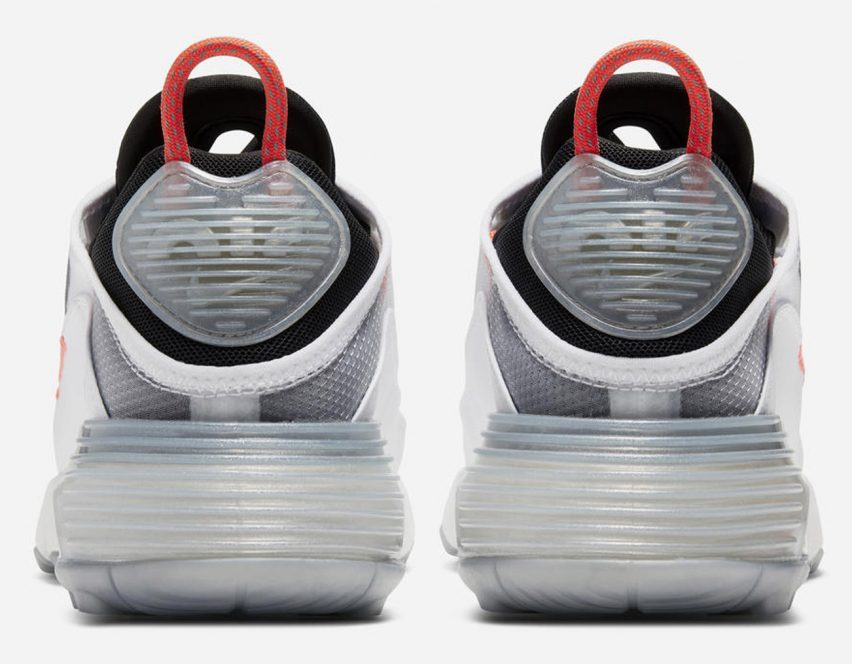
Nike designs Air Max 2090 to be "shoe of the future"
Sports brand Nike has created the Air Max 2090 to demonstrate what it sees as being the future of trainer design.
Air Max senior creative director Dylan Raasch said the product shows the way footwear has evolved in the past 30 years.
"The brief around the Air Max 2090 started as an exploration to see what the future might hold from a holistic footwear design perspective," he told Dezeen.

"The team came together and envisioned a future world using the learnings we have gained from the Air Max 90 up to today," said Raasch. "When everything was laid out we could clearly see a pattern of evolution that helped us identify the areas we could build on, as well as refine."
Released 30 years after the Air Max 90 was first launched in 1990, the Air Max 2090 is a simplified and refined version of the previous trainer. According to its designer, it demonstrates how sneaker design is evolving at Nike.
"What makes the Air Max 2090 the shoe of the future is that it is an example of how we see the future evolving," explained Raasch. "The iconic identifiers of what makes something unique becomes more refined and simplified over time allowing these elements to be celebrated."

The Air Max 2090 retains the mudguard, cassette and heel logo from the Air Max 90, but aims to the rest of the trainer to make it much more lightweight.
"The iconic mudguard, the horizontal fins on the moulded parts, and the framed window of the air unit where all elements that defined the 90 for us so we pulled up on those while leaving everything else in the background," explained Raasch.
"The Air Max 90 was the starting point for the 2090, which was inspired by Italian sports cars at the time, but because of the limited materials and manufacturing methods the shoe was built like a tank; which was perfect for the drum and bass and rave scenes that were happening at the time," he continued.
"We pulled up on that initial inspiration and really went back to the idea of speed, and light weight structure while still making sure the shoe was durable."

Nike has designed the Air Max 2090 to be as comfortable as possible, with the air of creating the substation of walking on air.
"The last important element of the future state of comfort," said Raasch. "Comfort continues to evolve and technology has progressively allowed for extended wear with reduced fatigue.
"The Air Max 2090 has 200 per cent more air than the Air Max 90, which helps us get ever closer to our ultimate goal of creating the sensation of walking on air," he continued.

The shoe was released in a colour way that highlights each of trainer's elements different functions and nods towards the future of car design.
In the design the most supportive materials are opaque, while the lights materials are see-through. The front and rear of the trainer are designed to invoke headlights and taillights on electric cars.
According to Raasch, the Air Max 2090 demonstrates how much trainer technology has advanced since the Air Max 90 was released.
"Over the past 30 years technology has improved tremendously and it's almost fully aligned to what our ultimate vision of what the future of trainers can be," he said.

"I think it would be safe to say comfort if the most significant area where trainers have evolved" Raasch continued. "For Air Max, the cushioning system was very rudimentary in its initial stages, it was two plastic films melted together and filled with air."
"Over the years manufacturing has improved and we have been able to build the bag to its optimal proportions, use materials that allow for the perfect flex and support, all while moving into a more sustainable direction of manufacturing."
"It's a slow process but I think we will reach a point in the very near future where trainers will become something that forces people to change the way they think about sneakers."

Nike believes that as sportswear technology is rapidly evolving trainers in 30 years time will be dramatically different from today's shoes.
"Footwear innovation continues to evolve faster and faster and I think it will become more akin to a form of transportation than a mere foot covering," explained Raasch.
"If we look at the automotive industry we can see huge technological leaps occurring which forces one rethink what a car really is. In the same way, we think trainers will quickly evolve into something more beneficial and purposeful and make us questions what a trainer really is."

"As culture shifts, so will aesthetics, so it's hard to predict what the style will be in 30 years' time, but it's safe to say that if you can imagine it, we are working on it," continued Raasch.
Nike's legendary shoe designer Tinker Hatfield came up with the idea to expose air pockets in the sole of the Air Max 1 running shoe in the 1980s, marking the start of the Air Max product line.
The innovative line has since developed with designs that include two air cushions, and then the full-length air bag first released in 1997.
More recent adaptations have included the Air Max 720, which was released in 2018 and featured the tallest airbag cushion.